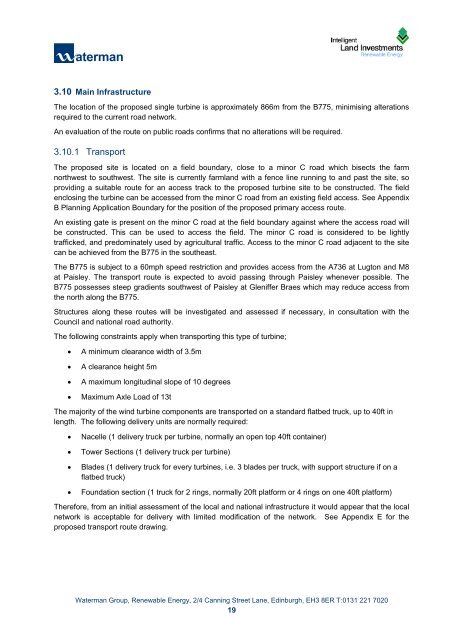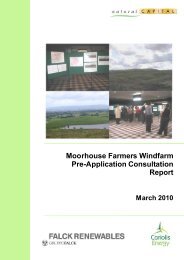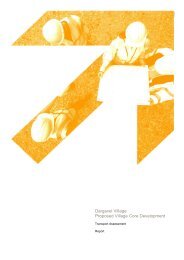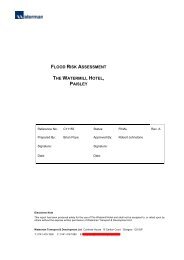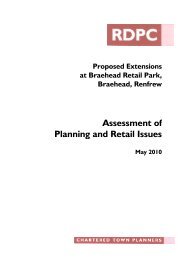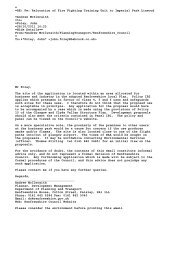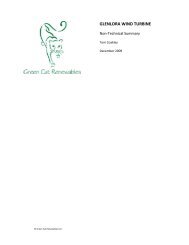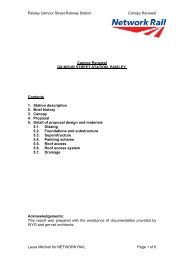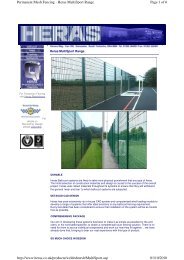Supporting Documentation - Renfrewshire Council
Supporting Documentation - Renfrewshire Council
Supporting Documentation - Renfrewshire Council
You also want an ePaper? Increase the reach of your titles
YUMPU automatically turns print PDFs into web optimized ePapers that Google loves.
3.10 Main Infrastructure<br />
The location of the proposed single turbine is approximately 866m from the B775, minimising alterations<br />
required to the current road network.<br />
An evaluation of the route on public roads confirms that no alterations will be required.<br />
3.10.1 Transport<br />
The proposed site is located on a field boundary, close to a minor C road which bisects the farm<br />
northwest to southwest. The site is currently farmland with a fence line running to and past the site, so<br />
providing a suitable route for an access track to the proposed turbine site to be constructed. The field<br />
enclosing the turbine can be accessed from the minor C road from an existing field access. See Appendix<br />
B Planning Application Boundary for the position of the proposed primary access route.<br />
An existing gate is present on the minor C road at the field boundary against where the access road will<br />
be constructed. This can be used to access the field. The minor C road is considered to be lightly<br />
trafficked, and predominately used by agricultural traffic. Access to the minor C road adjacent to the site<br />
can be achieved from the B775 in the southeast.<br />
The B775 is subject to a 60mph speed restriction and provides access from the A736 at Lugton and M8<br />
at Paisley. The transport route is expected to avoid passing through Paisley whenever possible. The<br />
B775 possesses steep gradients southwest of Paisley at Gleniffer Braes which may reduce access from<br />
the north along the B775.<br />
Structures along these routes will be investigated and assessed if necessary, in consultation with the<br />
<strong>Council</strong> and national road authority.<br />
The following constraints apply when transporting this type of turbine;<br />
• A minimum clearance width of 3.5m<br />
• A clearance height 5m<br />
• A maximum longitudinal slope of 10 degrees<br />
• Maximum Axle Load of 13t<br />
The majority of the wind turbine components are transported on a standard flatbed truck, up to 40ft in<br />
length. The following delivery units are normally required:<br />
• Nacelle (1 delivery truck per turbine, normally an open top 40ft container)<br />
• Tower Sections (1 delivery truck per turbine)<br />
• Blades (1 delivery truck for every turbines, i.e. 3 blades per truck, with support structure if on a<br />
flatbed truck)<br />
• Foundation section (1 truck for 2 rings, normally 20ft platform or 4 rings on one 40ft platform)<br />
Therefore, from an initial assessment of the local and national infrastructure it would appear that the local<br />
network is acceptable for delivery with limited modification of the network. See Appendix E for the<br />
proposed transport route drawing.<br />
Waterman Group, Renewable Energy, 2/4 Canning Street Lane, Edinburgh, EH3 8ER T:0131 221 7020<br />
19<br />
K:\Projects\CIV12920_ILI Windfarms_Batch 7\CIV12920_XXX_Hartfield<br />
Farm\Documents\Reports\CIV12920_1202xx_Hartfield_<strong>Supporting</strong> Turbine Assessment_225kW.docx


